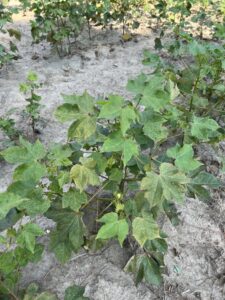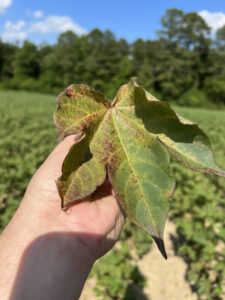Spider Mites Are a Problem in Cotton
go.ncsu.edu/readext?873648
en Español / em Português
El inglés es el idioma de control de esta página. En la medida en que haya algún conflicto entre la traducción al inglés y la traducción, el inglés prevalece.
Al hacer clic en el enlace de traducción se activa un servicio de traducción gratuito para convertir la página al español. Al igual que con cualquier traducción por Internet, la conversión no es sensible al contexto y puede que no traduzca el texto en su significado original. NC State Extension no garantiza la exactitud del texto traducido. Por favor, tenga en cuenta que algunas aplicaciones y/o servicios pueden no funcionar como se espera cuando se traducen.
Português
Inglês é o idioma de controle desta página. Na medida que haja algum conflito entre o texto original em Inglês e a tradução, o Inglês prevalece.
Ao clicar no link de tradução, um serviço gratuito de tradução será ativado para converter a página para o Português. Como em qualquer tradução pela internet, a conversão não é sensivel ao contexto e pode não ocorrer a tradução para o significado orginal. O serviço de Extensão da Carolina do Norte (NC State Extension) não garante a exatidão do texto traduzido. Por favor, observe que algumas funções ou serviços podem não funcionar como esperado após a tradução.
English
English is the controlling language of this page. To the extent there is any conflict between the English text and the translation, English controls.
Clicking on the translation link activates a free translation service to convert the page to Spanish. As with any Internet translation, the conversion is not context-sensitive and may not translate the text to its original meaning. NC State Extension does not guarantee the accuracy of the translated text. Please note that some applications and/or services may not function as expected when translated.
Collapse ▲
Cotton plants with leaves exhibiting typical stippling from spider mite feeding. Feeding is generally worse on older leaves lower in the canopy.
With hot, dry sustained weather across the state, odd issues are showing up. A couple weeks ago, we had a rash of false chinch bug in some parts of the state. Fortunately they didn’t amount to much injury on the plants and have dissipated with some of the rain we have caught. However, spider mites have now taken hold and should be a considered for any insecticide applications we make going forward.
Spider mites reproduce best on cotton that is stressed and reproduce more quickly in warm weather. We’ve had both! Also, a fungus that often holds back spider mite populations thrives better in wet and humid conditions that we have been lacking. Hopefully this fungus shows up soon, but I have not heard of it yet.
First, it’s important we don’t make the spider mite problem worse with tarnished plant bug sprays. See our previous recommendations for how to avoid flaring pests at this point in the season. Products like Orthene are effective for plant bugs, but tend to knock out beneficials. Also, some insecticides, like imidacloprid (Admire), as well as others, can trigger an increase in the survival and number of eggs spider mites lay. If you have to treat, reach for a softer insecticide like Transform. Transform supplies are tight at the moment and we have to make some hard decisions. An insecticide like Bidrin will kill natural enemies, but has less potential to flare spider mites than Orthene, a pyrethroid, or a neonicotinoid (Admire, Centric, for example) and is effective for managing tarnished plant bugs.

Spider mites feed on the lower part of the leaf and after they have fed for a while the upper part of the leaf may take on a bronzed appearance.
If spider mites are an issue that needs to be treated, our threshold (listed in the NC Cotton Insect Scouting Guide) is general leaf discoloration, chlorosis, bronzing, or both, plus live mites over most of the field and defoliation from mites in 25 percent or more of the field. If rain is imminent, delay treatment and reevaluate 3 to 4 days after the rain. If a miticide is used, 2 applications are sometimes necessary. An article published by a colleague at the University of TN does an excellent job of summarizing what miticides are effective.


